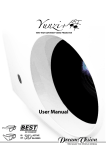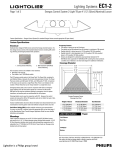Download SEMI
Transcript
Version 6 User Manual SEMI © 2005 BRUKER OPTIK GmbH, Rudolf Plank Str. 27, D-76275 Ettlingen, www.brukeroptics.com All rights reserved. No part of this manual may be reproduced or transmitted in any form or by any means including printing, photocopying, microfilm, electronic systems etc. without our prior written permission. Brand names, registered trademarks etc. used in this manual, even if not explicitly marked as such, are not to be considered unprotected by trademarks law. They are the property of their respective owner. The following publication has been worked out with utmost care. However, Bruker Optik GmbH does not accept any liability for the correctness of the information. Bruker Optik GmbH reserves the right to make changes to the products described in this manual without notice. This manual is the original documentation for the OPUS spectroscopic software. Table of Contents 1 Introduction . . . . . . . . . . . . . . . . . . . . . . . . . . . . . . . . . . . . . . . . . . . . . . . 1 2 Carbon - Oxygen Analysis . . . . . . . . . . . . . . . . . . . . . . . . . . . . . . . . . . . 2 2.1 2.2 2.3 3 Select Files . . . . . . . . . . . . . . . . . . . . . . . . . . . . . . . . . . . . . . . . . . . . . . . . . . . .3 Analysis Parameters . . . . . . . . . . . . . . . . . . . . . . . . . . . . . . . . . . . . . . . . . . . . .4 2.2.1 Oxygen / Carbon Methods . . . . . . . . . . . . . . . . . . . . . . . . . . . . . . . .4 2.2.2 Other Analysis Parameters . . . . . . . . . . . . . . . . . . . . . . . . . . . . . . . .6 Analysis Results . . . . . . . . . . . . . . . . . . . . . . . . . . . . . . . . . . . . . . . . . . . . . . . .7 Calculation Algorithms. . . . . . . . . . . . . . . . . . . . . . . . . . . . . . . . . . . . . . 8 3.1 3.2 3.3 3.4 3.5 3.6 3.7 3.8 3.9 3.10 3.11 Calculation of the Wafer Thickness . . . . . . . . . . . . . . . . . . . . . . . . . . . . . . . . .8 Ratio 1 Method - Oxygen . . . . . . . . . . . . . . . . . . . . . . . . . . . . . . . . . . . . . . . . .9 Ratio 2 Method - Oxygen . . . . . . . . . . . . . . . . . . . . . . . . . . . . . . . . . . . . . . . .10 Ratio Method - Carbon . . . . . . . . . . . . . . . . . . . . . . . . . . . . . . . . . . . . . . . . . .10 Pseudo ASTM Method - Oxygen . . . . . . . . . . . . . . . . . . . . . . . . . . . . . . . . . .12 Pseudo ASTM Method - Carbon . . . . . . . . . . . . . . . . . . . . . . . . . . . . . . . . . .13 ASTM F 1188-93a Method - Oxygen . . . . . . . . . . . . . . . . . . . . . . . . . . . . . .14 ASTM F 1391-92 Method - Carbon . . . . . . . . . . . . . . . . . . . . . . . . . . . . . . . .16 DIN 50438-1 A (93) Method - Oxygen . . . . . . . . . . . . . . . . . . . . . . . . . . . . .17 DIN 50438-1 B (93) Method - Oxygen . . . . . . . . . . . . . . . . . . . . . . . . . . . . .19 DIN 50438-2 (82) Method - Carbon. . . . . . . . . . . . . . . . . . . . . . . . . . . . . . . .22 Appendix . . . . . . . . . . . . . . . . . . . . . . . . . . . . . . . . . . . . . . . . . . . . . . . . 25 1 Introduction The software package OPUS/SEMI is intended for analyses in the field of semiconductor quality control. On the basis of an absorbance spectrum of a wafer, this OUS function calculates the impurity concentration of interstitial oxygen (Oi) and substitutional carbon (Cs) in silicon wafers. OPUS/SEMI provides evaluation methods based on the following ASTM and DIN standards: • • • • • ASTM F 1188-93a Oxygen ASTM F 1391-92 Carbon DIN 50438-1 A (93) Oxygen DIN 50438-1 B (93) Oxygen DIN 50438-2 (82) Carbon Besides the evaluation methods based on the above listed ASTM and DIN standards, the following methods are available: • The pseudo ASTM method which requires that the wafer thickness is already known. • The ratio method which automatically computes the wafer thickness from the silicon matrix peaks. • A special ratio method which is designed to deal with strongly curved baselines which can occur when analyzing samples with a rough surface and/or free charge carriers. Note: For the calculation algorithms of the available evaluation methods refer to chapter 3. The CARBon-OXygen Analysis function of OPUS/SEMI is suited for two types of wafers having different surface treatments: • Double-side polished or polish-etched wafers • Single-side polished wafers with etched back surfaces Bruker Optik GmbH OPUS/SEMI 1 Carbon - Oxygen Analysis 2 Carbon - Oxygen Analysis Before starting a Carbon - Oxygen Analysis, acquire an absorbance spectrum of a pure silicon wafer produced by float-zoning (reference wafer) and an absorbance spectrum of a silicon wafer containing Oi- and Cs-impurities (test wafer that is to be analyzed). Note: When setting up the general measurement parameters, define a resolution of 4.0 and a zerofilling factor of 2. After the measurement, load the files containing the absorbance spectra (reference and sample spectra) into OPUS. (See figure 1.) Test Wafer Spectrum Reference Wafer Spectrum Test Wafer Spectrum Reference Wafer Spectrum Figure 1: Absorbance Spectra for the Carbon - Oxygen Analysis 2 OPUS/SEMI Bruker Optik GmbH Select Files 2.1 Select Files To determine the impurity concentrations of interstitial oxygen (Oi) and substitutional carbon (Cs) in a silicon wafer, select in the OPUS Evaluate menu the CARBon-OXygen Analysis function. The following dialog window appears: Figure 2: Carbon-Oxygen Analysis Dialog Window - Select Files Drag and drop the absorbance data block of the reference wafer in the upper field Reference wafer spectrum and the absorbance data block(s) of the test wafer(s) in the lower field File(s) for CARBOX analysis. Note: The OPUS function CARBon - OXygen Analysis accepts only absorbance data blocks. Note: This OPUS function allows also the evaluation of a 3D data block (of the test wafer). In this case, the concentrations Oi and Cs are displayed as traces. Enter the thickness values (in mm) of the reference and the test wafer in the corresponding fields, provided that these values are known. For all evaluation methods - except for RATIO Method 1 and RATIO Method 2 - the thickness values of the reference and the test wafer need to be entered. If the thickness is unknown, enter the value 0. In this case, the thickness is calculated using the silicon phonon peak at 610cm-1. (The algorithm for the wafer thickness calculation is described in detail in chapter 3). Bruker Optik GmbH OPUS/SEMI 3 Carbon - Oxygen Analysis 2.2 Analysis Parameters Click on the Analysis Parameter tab. The following dialog window appears: Figure 3: Carbon-Oxygen Analysis Dialog Window - Analysis Parameters 2.2.1 Oxygen / Carbon Methods In this dialog window, you specify the parameters for the carbon-oxygen analysis. The following evaluation methods are available: • • • • • • • ASTM F 1188-93a / ASTM F 1391-92 DIN 50438-1 A (93) / ASTM F 1391-92 DIN 50438-1 B (93) / ASTM F 1391-92 RATIO-Method 1 RATIO-Method 2 Pseudo ASTM No Oxygen Analysis / DIN 50438-2 (82) The methods for calculating the interstitial oxygen concentration are: • • • • • • 4 ASTM F 1188-93a DIN 50438-1 A (93) DIN 50438-1 B (93) RATIO-Method 1 RATIO-Method 2 Pseudo ASTM OPUS/SEMI Bruker Optik GmbH Analysis Parameters The methods for calculating the substitutional carbon concentration are: • • • • ASTM F 1391-92 RATIO-Method Pseudo ASTM DIN 50438-2 (82) The RATIO - Methods 1 and 2 are suited for double-side polished wafers and for wafers with a rough backside. Using these methods, the height of the oxygen peak (at 1107cm-1) and the height of the carbon peak (at 605cm-1) are calculated for both spectra (i.e. the reference wafer spectrum and the test wafer spectrum). For this purpose, proper baselines are fitted. Then, a so-called ratio factor is calculated using the silicon peak at 738cm-1. The oxygen and carbon peak heights of reference wafer spectrum are multiplied with this ratio factor and subtracted from the peak height of the test wafer spectrum. Using the corrected peak heights, the software calculates the oxygen and carbon concentrations by dividing these peak heights by the height of the baseline corrected silicon peak at 617cm-1 of the test wafer spectrum and multiplying it by appropriate proportional factors. In case of RATIO-Method 1, linear baselines are fitted, whereas in case of RATIO-Method 2 a quadratic polynomial is used for the oxygen baseline. This method can be used for spectra with a strong curved baseline. The Pseudo ASTM Method can only be used for silicon slices polished on both sides. Taking the multiple reflections on both wafer surfaces into account, the formula for calculating the transmittance spectrum (T=10-Absorbance) is: 2 – αd 1 – R) e T = (-----------------------------2 – 2αd 1–R e with d being the wafer thickness and R being the reflectivity (0.3). Using the this formula, the absorption coefficient α is calculated. The α-values for the peak and the baseline point are evaluated and then the baseline value is subtracted from the peak value. This is done for both the reference wafer spectrum and the test wafer spectrum. Then, the α-values from the reference measurement are subtracted from those of the test wafer spectrum. These corrected α-values are proportional to the impurity concentrations. Note: The complete calculation algorithms for all evaluation methods are described in chapter 3. If you are not sure which oxygen / carbon method you should use, select ASTM F 1188-93a (oxygen) and ASTM F 1391-92 (carbon). Bruker Optik GmbH OPUS/SEMI 5 Carbon - Oxygen Analysis 2.2.2 Other Analysis Parameters In the group field Units, specify the unit (ppm atomic or atoms/ccm) in which the concentration values in the Quant report are to be displayed by clicking on the corresponding option button. In the group field Conversion Coefficients, specify the conversion coefficients for oxygen and carbon. These conversion coefficients are multiplied by the absorption coefficients for the oxygen peak and the carbon peak to get the concentration values. For the evaluation methods based on ASTM standards, the default values of the conversion coefficients are: oxygen: 3.14 E17/cm and carbon: 0.82 E17/cm. The multiplication factors Factor FO (oxygen) and Factor FC (carbon) have the default value 1. If you measure calibration wafers with known oxygen and carbon concentrations you can use these factors for your calibration. In the group field Thickness Calculation you specify the Offset and the Slope. The default parameters are only valid for double-side polished wafers and a certain thickness range (approx. from 0.3 to 2.5mm). If your wafer does not fulfill the above mentioned conditions concering surface treatment and thickness, you need to change these default values. Note: It is better to work with known thickness values than to calculate them on the basis of the FT-IR spectrum as described in chapter 3, section 3.1. In case of the method DIN 50438-1 A (93), the concentration of the free charge carriers needs to be entered as well. See figure 4. Parameters of the Charge Carrier Concentration Figure 4: Analysis Parameters of the Charge Carrier Concentration 6 OPUS/SEMI Bruker Optik GmbH Analysis Results 2.3 Analysis Results After having entered all analysis parameters, click on the Analyze button. (See figure 4.) The results of a carbon-oxygen analysis are stored in a Quant data block (figure 5) which is attached to the test wafer spectrum file. To display the analysis results, double-click on the Quant data block. As a result, the OPUS report window opens. Depending on the number of analyses (e.g. using different methods) you have performed, there are several carbon oxygen analysis reports displayed in form of a directory tree. Clicking on one of them displays the corresponding analysis result. Quant Data Block Carbon Oxygen Analysis Reports Used Analysis Parameters Analysis Results Figure 5: OPUS Report Window Bruker Optik GmbH OPUS/SEMI 7 Calculation Algorithms 3 Calculation Algorithms This chapter describes the calculation algorithms of the different methods for determining the oxygen and the carbon impurity concentrations. 3.1 Calculation of the Wafer Thickness For the calculation of the wafer thickness, the silicon phonon peak at 610cm-1 in the absorbance spectrum is used. 1) The absorption values of the three data points at the wavenumbers 617.18, 619.1 and 615.26cm-1 are averaged. (The data point nearest to the specified wavenumber is chosen.) Note: These data points are not exactly in the center of the peak, but slightly offcenter. 2) The baseline is a straight line calculated by fitting the six data points (the data point at 651.9cm-1 and the two neighboring data points as well as the data point at 576.68cm-1 and the two neighboring data points) using the least-squares method. 3) The y-value of the baseline at 617.18cm-1 is determined. 4) This value is subtracted from the absorption value calculated in step 1. The result is called AD. 5) The wafer thickness is calculated using the following empirical formula: d[mm] = 0.02563 + 2.91474 • AD with 0.02563 being the default Offset value and 2.91474 being the default Slope value. Note: This formula can only be used for double-side polished wafers having a certain thickness range (approx. from 0.3 to 2.5mm). For a more flexible thickness calculation, the parameters Offset (a) and Slope (b) in the above formula are free parameters: d[mm] = a + b • AD 8 OPUS/SEMI Bruker Optik GmbH Ratio 1 Method - Oxygen 3.2 Ratio 1 Method - Oxygen 1) The data point at 1107.08cm-1 and two data points on the right and two data points on the left (totally 5 data points) are used for a least squares fit to a parabola. 2) The y-value of this parabola (AP) at the wavenumber 1107.08cm-1 is determined. 3) A linear baseline is calculated by fitting six data points (the data point at 1299.9cm-1 and two neighboring data points as well as the data point at 940cm-1 and two neighboring data points) using the least squares method. 4) The y-value of the baseline (AB) at 1107.08cm-1 is determined. 5) The difference A P – A B for both the test wafer spectrum and the reference wafer spectrum are calculated. The results are AT (absorption value of the test wafer spectrum) and AR (absorption value of the reference wafer spectrum). 6) For the calculation of the so-called ratio factor (R), the silicon peak at 738cm-1 is used. The y-values of the data points at 740.6, 738.0 and 736.0cm-1 are averaged. The calculated average value ASIP is taken as intensity of the peak maximum. 7) For the calculation of the baseline, five data points are used. The absorption value of the left baseline point (BL) is the mean value of the y-values at 1043.4, 1041.5 and 1039.6cm-1. The absorption value of the right baseline point (BR) is the mean value of the y-values at 700 and 698cm-1. The value of the baseline (ASIB) at 738 cm-1 is calculated using the following formula: ASI B = (BL • 40 + BR • 300) 340 8) The difference ASI P – ASI B for both the test wafer and the reference wafer spectrum are calculated. The results are ASIT and ASIR. 9) The ratio factor R is calculated as follows: R = ASI T ASI R 10) The absorption value of oxygen (Ao) is calculated using the following equation: AO = AT - R • AR Bruker Optik GmbH OPUS/SEMI 9 Calculation Algorithms 11) The oxygen concentration co is calculated using the following formula: A O • 3.14 • 17 - 2 -1 c O = 6.4 cm • 10 cm AD with AD being the absorption value (at 610cm-1,silicon peak) which has been calculated in the course of the thickness calculation for the test wafer spectrum (See section 3.1.) The factor 3.14 is the conversion coefficient (oxygen) which can be changed by the user in the CARBon-OXygen Analysis dialog window. 12) Then, the calculated oxygen concentration value is multiplied by the factor FO (Factor Oxygen), which can be specified by the user: C O = cO • FO Note: The thickness value is not used for the oxygen concentration calculation. Only the baseline corrected absorption value AD of the silicon peak at 610cm-1 has an influence on the oxygen concentration calculation. 3.3 Ratio 2 Method - Oxygen The difference between Ratio 1 Method and Ratio 2 Method concerns only step 3. For determining the absorption value of the baseline (AB), a parabola is fitted. A parabolic baseline is calculated by fitting the following 12 data points: • • • • 3.4 data point at 1299.9cm-1 and the two neighboring data points data point at 1180cm-1 and the two neighboring data points data point at 1040cm-1 and the two neighboring data points data point at 940cm-1 and the two neighboring data points Ratio Method - Carbon 1) The data point at 605.6cm-1 and two data points on the right and two data points on the left (totally 5 data points) are used for a least squares fit to a parabola. 2) The y-value of the parabola (AP) at the wavenumber 605.6cm-1 is determined. 3) A linear baseline is calculated by fitting six data points (the data point at 622.97cm-1 and the two neighboring data points as well as the data point at 567.04cm-1 and the two neighboring data points) using the least square method. 4) The y-value of the baseline (AB) at 605.6cm-1 is determined. 10 OPUS/SEMI Bruker Optik GmbH Ratio Method - Carbon 5) The difference A P – A B for both the test wafer spectrum and the reference wafer spectrum are calculated. The results are AT (absorption value of the test wafer spectrum) and AR (absorption value of the reference wafer spectrum). 6) For the calculation of the so-called ratio factor (R), the silicon peak at 738cm-1 is used. The y-values of the data points at 740.6, 738.0 and 736.0cm-1 are averaged. This average value ASIP is taken as intensity of the peak maximum. 7) For the calculation of the baseline, five data points are used. The absorption value of the left baseline point (BL) is the average value of the yvalues at the wavenumbers 1043.4, 1041.5 and 1039.6cm-1. The absorption value of the right baseline point (BR) is the average value of the yvalues at the wavenumbers 700 and 698cm-1. The value the baseline (ASIB) at 738cm-1 is calculated using the following formula: ASI B = (BL • 40 + BR • 300) 340 8) The difference ASI P – ASI B for both the test wafer spectrum and the reference wafer spectrum are calculated. The results are ASIT and ASIR. 9) The ratio factor R is calculated as follows: R = ASI T ASI R 10) The absorption value of carbon (AC) is calculated using the following equation: AC = AT - R • AR 11) The carbon concentration cC is calculated using the formula: AC • 8.2 • 16 - 2 -1 cC = 10.14 cm • 10 cm AD with AD being the absorption value (at 610cm-1, silicon peak) which has been calculated in the course of the thickness calculation for the test wafer spectrum. (See section 3.1.) The factor 8.2 is the conversion coefficient (carbon) which can be changed by the user in the CARBon-OXygen Analysis dialog window. The carbon concentration value is multiplied by the factor FC, which can be specified by the user: C C = cC • FC Bruker Optik GmbH OPUS/SEMI 11 Calculation Algorithms Note: The thickness value is not used for the oxygen concentration calculation. Only the baseline corrected absorbance value AD of the silicon peak at 610cm-1 has an influence on the oxygen concentration calculation. 3.5 Pseudo ASTM Method - Oxygen 1) The thickness of reference wafer and test wafer are determined by either measuring the thickness using a caliper gauge or calculating the thickness using the silicon phonon peak at 610cm-1 in the absorbance spectra. (See section 3.1.) Note: First the oxygen absorption coefficients are calculated separately for test wafer spectrum and reference wafer spectrum. 2) The data point at 1107.08cm-1 and two data points on the right and two data points on the left (totally 5 data points) are used for a least squares fit to a parabola. 3) The y-value of this parabola (AP) at the wavenumber 1107.08cm-1 is determined. 4) A linear baseline is calculated by fitting six data points (the data point at 1299.9cm-1 and the two neighboring data points as well as the data point at 940cm-1 and the two neighboring data points) using the least squares method. 5) The y-value of the baseline (AB) at 1107.08cm-1 is determined. 6) The absorption coefficients α for AP and AB are calculated using the following formula: 1 d α = - ln 2 4 - (1 - R ) + (1 - R ) + 4 T 2 R 2 2 T R2 with d being the wafer thickness, R (ratio factor) having the value 0.3 and T = 10-A. 7) The absorption coefficient calculated for the baseline point is subtracted from the absorption coefficient calculated for the peak at 1107cm-1 (αP - αB). The results are net absorption coefficients for the test wafer and the reference wafer (αT and αR). 8) To calculate the absorption coefficient for oxygen αO the net absorption coefficient of the test wafer is subtracted from the net absorption coefficient of the reference wafer: αO =αT - α R 12 OPUS/SEMI Bruker Optik GmbH Pseudo ASTM Method - Carbon 9) The oxygen concentration cO is calculated by multiplying the absorption coefficient αO by a calibration factor: cO = 3.14 • 10 cm α O 17 -2 This calibration factor is also called conversion coefficient. The default value is 3.14 x 1017cm-2. This value can be changed by the user in the CARBon-OXygen Analysis dialog window. 10) The oxygen concentration value cO (calculated in step 9) is multiplied by the factor FO (default value FO=1), which can be specified by the user in the CARBon-OXygen Analysis dialog window: C O = cO • FO 3.6 Pseudo ASTM Method - Carbon 1) The thickness of reference wafer and test wafer are determined by either measuring the thickness using a caliper gauge or by calculating the thickness using the silicon phonon peak at 610cm-1 in the absorbance spectra. (See section 3.1.) Note: First the carbon absorption coefficients are calculated separately for test wafer spectrum and reference wafer spectrum. 2) The data point at 605.6cm-1 and two data points on the right and two data points on the left (totally 5 data points) are used for a least squares fit to a parabola. 3) The y-value of the parabola (AP) at the wavenumber 605.6cm-1 is determined. 4) A linear baseline is calculated by fitting six data points (the data point at 622.97cm-1 and the two neighboring data points as well as the data point at 567.04cm-1 and the two neighboring data points) using the least squares method. 5) The y-value of the baseline (AB) at 605.6cm-1 is determined. 6) The absorption coefficients α for AP and AB are calculated using the following formula: 2 4 1 - (1 - R ) + (1 - R ) + 4 T 2 R 2 α = - ln d 2 T R2 with d being the wafer thickness, R (ratio factor) having the value 0.3 and T = 10-A. Bruker Optik GmbH OPUS/SEMI 13 Calculation Algorithms 7) The absorption coefficient calculated for the baseline point is subtracted from the absorption coefficient calculated for the peak (at 605cm-1) αP - αB. The results are net absorption coefficients for the test wafer and the reference wafer (αT and αR). 8) To calculate the absorption coefficient for carbon (αC), the net absorption coefficient of the test wafer is subtracted from the net absorption coefficient of the reference wafer: αC = αT - α R 9) The carbon concentration cC is calculated by multiplying the absorption coefficient αC by a calibration factor: cC = 8.2 • 10 cm α C 16 -2 This calibration factor is also called conversion coefficient. The default value is 8.2 x 1016cm-2. This value can be changed by the user in the CARBon-OXygen Analysis dialog window. 10) The carbon concentration value cC (calculated in step 9) is multiplied by the factor FC (default value FC=1), which can be specified in the CARBon-OXygen Analysis dialog window: C C = cC • FC 3.7 ASTM F 1188-93a Method - Oxygen 1) The thickness of reference wafer and test wafer are determined by either measuring the thickness using a caliper gauge or by calculating the thickness using the silicon phonon peak at 610cm-1 in the absorbance spectra. (See section 3.1.) 2) The absorbance spectrum of the reference wafer is multiplied by the factor d m ⁄ d r (with dm being the thickness of the test wafer and dr being the thickness of the reference wafer). 3) The normalized absorbance spectrum of the reference wafer is subtracted from the absorbance spectrum of the test wafer. 4) The maximum absorbance value of the oxygen peak at 1107cm-1 is determined. 5) This data point plus two data points on the right and two data points on the left (totally 5 data points) are used for a least squares fit to a parabola. 14 OPUS/SEMI Bruker Optik GmbH ASTM F 1188-93a Method - Oxygen 6) The wavenumber of the parabola vertex vmax and the corresponding absorption value AP are determined. 7) On the basis of the spectrum calculated in step 3, a linear baseline is calculated by fitting data points in the regions from 900 to 1000cm-1 and from 1200 to 1300cm-1 using the least squares method. 8) The absorption value of the baseline AB at the wavenumber vmax is determined. 9) The transmittance values, which correspond to the absorbance values AP and AB, are calculated: T P = 10 - AP T B = 10 - AB 10) The absorption coefficients αP and αB for the peak maximum and the baseline point are calculated using the following formula: 2 1 (0.09 - e1.7d ) + (0.09 - e1.7d ) + 0.36 T 2 e1.7d α = - ln 0.18 T d with d being the thickness of the test wafer. 11) The absorption coefficient for oxygen αO is calculated: αO=α P -α B 12) The oxygen concentration cO is calculated by multiplying the absorption coefficient αO by a calibration factor (IOC-88): cO = 3.14 • 10 cm α O 17 -2 This calibration factor is also called conversion coefficient. The default value is 3.14 x 1017cm-1. This value can be changed by the user in the CARBon-OXygen Analysis dialog window. 13) The oxygen concentration value cO is multiplied by the factor FO (default value FO=1), which can be specified by the user in the CARBon-OXygen Analysis dialog window. C O = cO • FO Bruker Optik GmbH OPUS/SEMI 15 Calculation Algorithms 3.8 ASTM F 1391-92 Method - Carbon 1) The thickness of reference wafer and test wafer are determined by either measuring the thickness using a caliper gauge or by calculating the thickness using the silicon phonon peak at 610cm-1 in the absorbance spectra. (See section 3.1.) 2) The absorbance spectrum of the reference wafer is multiplied by the factor d m ⁄ d r (with dm being the thickness of the test wafer and dr being the thickness of the reference wafer). 3) The normalized absorbance spectrum of the reference wafer is subtracted from the absorbance spectrum of the test wafer. 4) The maximum absorbance value of the carbon peak at 605cm-1 is determined. 5) This data point plus two data points on the right and two data points on the left (totally 5 data points) are used for a least squares fit to a parabola. 6) The wavenumber of the parabola vertex vmax and the corresponding absorption value AP are determined. 7) On the basis of the spectrum calculated in step 3, a linear baseline is calculated by fitting data points in the regions from 550 to 570cm-1 and from 630 to 650cm-1 using the least squares method. 8) The absorption value of the baseline AB at the wavenumber vmax is determined. 9) The absorption coefficient for carbon αC is calculated using the following formula: αC = 23.03 ( AP - AB ) d with d being the thickness of the test wafer. 10) The carbon concentration cC is calculated by multiplying the absorption coefficient αC by a calibration factor: cC = 8.2 • 10 cm α C 16 -2 This calibration factor is also called conversion coefficient. The default value is 8.2 x 1016cm-2. This value can be changed by the user in the CARBon-OXygen Analysis dialog window. 16 OPUS/SEMI Bruker Optik GmbH DIN 50438-1 A (93) Method - Oxygen Note: The conversion coefficient (0.82 x 1017cm-2) is valid for spectra acquired at room temperature. But this method can also be used for spectra acquired at cryogenic temperatures (below 80 K). In this case, the absorption band peak is at 607.5cm-1 and the recommended conversion coefficient is 0.37 x 1017cm-2. 11) The carbon concentration value cC is multiplied by the factor FC (default value FC=1) which can be specified by the user in the CARBon-OXygen Analysis dialog window. C C = cC • FC 3.9 DIN 50438-1 A (93) Method - Oxygen 1) The thickness of reference wafer and test wafer are determined by either measuring the thickness using a caliper gauge or by calculating the thickness using the silicon phonon peak at 610cm-1 in the absorbance spectra. (See section 3.1.) 2) The absorbance spectrum of the reference wafer is multiplied by the factor d m ⁄ d r (with dm being the thickness of the test wafer and dr being the thickness of the reference wafer). 3) The absorbance spectra are converted into transmittance spectra (Tr = 10-Abs). 4) A so-called comparison spectrum is calculated by dividing the test wafer spectrum by the reference wafer spectrum. 5) The minimum transmittance value of the oxygen peak at 1107cm-1 is determined. 6) This data point plus two data points on the right and two data points on the left (totally 5 data points) are used for a least squares fit to a parabola. 7) The wavenumber of the parabola vertex vmin and the corresponding transmittance value TM are determined. 8) On the basis of the spectrum calculated in step 4, a linear baseline is calculated by fitting data points in the regions from 1025 to 1040cm-1 and from 1180 to 1195cm-1 using the least squares method. 9) The transmittance value of the baseline TB at the wavenumber vmin is determined. 10) The absorption coefficient for oxygen aO is calculated using the following formula: Bruker Optik GmbH OPUS/SEMI 17 Calculation Algorithms αO= - ln ( A + A2 + B 2 ) d with: A = T B ( 1 - B2 ) 2TM B= 1 exp( αd) R α = α A = α phon + α N α phon = 0.85 cm-1 p - Si : α N = 1.43 • 10 -16 cm2 N(p) n - Si : α N = 0.32 • 10 -16 cm2 N(n) with N(n) and N(p) being the free charge carrier concentrations for pand n-type silicon. 11) The oxygen concentration cO is calculated by multiplying the absorption coefficient αO by a calibration factor: cO = 3.14 • 10 cm α O 17 -2 This calibration factor is also called conversion coefficient. The default value is 3.14 x 1017cm-2. This value can be changed by the user in the CARBon-OXygen Analysis dialog window. 12) The concentration value cO is multiplied by the factor FO, which can be specified by the user in the CARBon-OXygen Analysis dialog window: C O = cO • FO 18 OPUS/SEMI Bruker Optik GmbH DIN 50438-1 B (93) Method - Oxygen 3.10 DIN 50438-1 B (93) Method - Oxygen 1) The thickness of reference wafer and test wafer are determined by either measuring the thickness using a caliper gauge or by calculating the thickness using the silicon phonon peak at 610cm-1 in the absorbance spectra. (See section 3.1.) 2) The absorbance spectrum of the reference wafer is multiplied by the factor d m ⁄ d r (with dm being the thickness of the test wafer and dr being the thickness of the reference wafer). 3) The absorbance spectra are converted into transmittance spectra (Tr = 10-Abs). After that, the leveled transmittance spectrum of the test wafer is calculated as follows: 4) Θ a is the transmittance value at 1107cm-1 of curve a in figure 6. 5) This spectrum (curve a in figure 6) is leveled linearly in such a way that the transmittances values at the wavenumbers 1200cm-1 and 1025cm-1 are identical. (See curve b in figure 6). 6) Θ b is the transmittance value at 1107cm-1 of the linearly leveled spectrum. (See curve b in figure 6). 7) The linearly leveled spectrum (curve b in figure 6) is multiplied by Θ a ⁄ Θ b . The result is the leveled spectrum. (See curve c in figure 6). Figure 6: Leveling the Spectrum of a single-side polished Test Wafer (Source: DIN 50438-1: Prüfung von Materialien für die Halbleitertechnologie - Bestimmung des Verunreinigungsgehaltes in Silicium mittels Infrarot-Absorption - Teil 1, Berlin: Beuth Verlag GmbH (1995-07). Bruker Optik GmbH OPUS/SEMI 19 Calculation Algorithms 8) Θ t is the transmittance value at 1188cm-1 of the leveled spectrum. (See curve c in figure 6). After that, the adjusted transmittance spectrum of the reference wafer is calculated as follows: 9) The transmittance value Θ r at 1188cm-1 in the reference spectrum is determined. This value has been corrected for thickness (step 2 and 3). 10) This spectrum is multiplied by the factor Θ t ⁄ Θ r . The result is an adjusted transmittance spectrum. 11) Θ R is the transmittance value at 1107cm-1. This value is required for the calculation of absorption coefficient αB. (See step 13.) 12) The leveled test wafer spectrum (curve c in figure 6) is divided by the adjusted reference wafer spectrum to obtain the comparison spectrum T. 13) The absorption coefficient αB is calculated using the following formula: αB= - ln ( D + D 2 + 11.111 ) d with d being the thickness of the test wafer. The parameter D is calculated as follows: D= - 2.722 ΘR Using the comparison spectrum T, the values TM and TB are calculated as follows: 14) The minimum transmittance value of the oxygen peak at 1107cm-1 is determined. 15) This data point plus two data points on the right and two data points on the left (totally 5 data points) are used for a least squares fit to a parabola. 16) The wavenumber of the parabola vertex vmin and the corresponding intensity value TM are determined. 17) A linear baseline is calculated by fitting data points in the regions from 1025 to 1040cm-1 and from 1180 to 1195cm-1 using the least squares method. 18) The transmittance value of the baseline TB at the wavenumber vmin is determined. 20 OPUS/SEMI Bruker Optik GmbH DIN 50438-1 B (93) Method - Oxygen 19) The absorption coefficient for oxygen αO is calculated using the following formula: αO= - ln ( A + A2 + B 2 ) d with: A = T B ( 1 - B2 ) 2TM B= 1 exp( α B d) R with αB being the absorption coefficient which has been calculated in step 13 and d being the thickness of the test wafer. 20) The oxygen concentration is calculated by multiplying the absorption coefficient cO by the calibration factor: cO = 3.14 • 10 cm α O 17 -2 This calibration factor is also called conversion coefficient. The default value is 3.14 x 1017cm-2. This value can be changed by the user in the CARBon-OXygen Analysis dialog window. 21) The oxygen concentration value is multiplied by the factor FO which can be specified by the user in the CARBon-OXygen Analysis dialog window: C O = cO • FO Bruker Optik GmbH OPUS/SEMI 21 Calculation Algorithms 3.11 DIN 50438-2 (82) Method - Carbon 1) The thickness of reference wafer and test wafer are determined by either measuring the thickness using a caliper gauge or by calculating the thickness using the silicon phonon peak at 610cm-1 in the absorbance spectra. (See section 3.1.) 2) The absorbance spectrum of the reference wafer is multiplied by the factor d m ⁄ d r (with dm being the thickness of the test wafer and dr being the thickness of the reference wafer). 3) The absorbance spectra are converted into transmittance spectra (Tr = 10-Abs). 4) A so-called comparison spectrum is calculated by dividing the test wafer spectrum by the reference wafer spectrum. 5) The minimum transmittance value of the carbon peak at 605cm-1 is determined (provided that the spectrum has been acquired at room temperature). Note: In case the spectrum has been acquired at cryogenic temperatures, the minimum transmittance value of the carbon peak at 607.5cm-1 is determined. 6) This data point plus two data points on the right and two data points on the left (totally 5 data points) are used for a least squares fit to a parabola. 7) The wavenumber of the parabola vertex vmin and the corresponding transmittance value TM are determined. 8) The baseline is constructed as a tangent to the comparison spectrum in such a way that the spectrum contacts it at least at one point on each side of the absorption band, but it is not cut at any point. 9) The transmittance value of the baseline TB at the wavenumber vmin is determined. 10) The absorption coefficient for carbon αC is calculated using the following formula: αc= ln ( T B / T M ) d 11) The carbon concentration cc is calculated by multiplying the absorption coefficient αC by a calibration factor: cc = 1.0 • 10 cm α c 17 22 OPUS/SEMI -2 Bruker Optik GmbH DIN 50438-2 (82) Method - Carbon This calibration factor is also called conversion coefficient. The default value is 1.0 x 1017cm-2. This value can be changed by the user in the CARBon-OXygen Analysis dialog window. Note: The conversion coefficient (1.0 x 1017cm-2) is valid for spectra acquired at room temperature. But this method can also be used for spectra acquired at cryogenic temperatures (below 80 K). In this case, the absorption band peak is at 607.5cm-1 and the recommended conversion coefficient is 0.45 x 1017cm-2. 12) The concentration value cc is multiplied by the factor FC, which can be specified by the user in the CARBon-OXygen Analysis dialog window: C c = cc • FC Bruker Optik GmbH OPUS/SEMI 23 Calculation Algorithms 24 OPUS/SEMI Bruker Optik GmbH Appendix ASTM and DIN Standards As already mentioned in chapter 1, the OPUS/SEMI software supports the following ASTM and DIN standards: • • • • • ASTM F 1188-93a Oxygen ASTM F 1391-92 Carbon DIN 50438-1 A (93) Oxygen DIN 50438-1 B (93) Carbon DIN 50438-2 (82) Carbon It is highly recommended to purchase these standards. You can order them, for example, at the Beuth Verlag GmbH (www.beuth.de) or at ASTM International (www.astm.org). This appendix quotes the scope or range of application and purpose of the following standards: • • • • ASTM F 1188-93a ASTM F 1391-92 DIN 50438-1 DIN 50438-2 (82) ASTM F 1188-93a1 Standard Test Method for Interstitial Atomic Oxygen Content of Silicon by Infrared Absorption 1. Scope 1.1 This test method covers the determination of the interstitial oxygen content of single crystal silicon by infrared spectroscopy. This test method requires the use of an oxygen-free reference specimen. (...) 1.2 The useful range of oxygen concentration measurable by this test method is from 1 x 1016 atoms/cm3 to the maximum amount of interstitial oxygen soluble in silicon. 1.3 The oxygen concentration obtained using this test method assumes a linear relationship between the interstitial oxygen concentration and the absorption coefficient of the 1107cm-1 band associated with interstitial oxygen in silicon. 1.4 (...) 1. ASTM F 1188-93a (Published 1993): Standard Test Method for Interstitial Atomic Oxygen Content of Silicon by Infrared Absorption. ASTM International, West Conshohocken, Pennsylvania, U.S. Bruker Optik GmbH OPUS SEMI 25 Appendix ASTM F 1391-921 Standard Test Method for Substitutional Atomic Carbon Content of Silicon by Infrared Absorption 1. Scope 1.1 This referee test method covers the determination of substitutional carbon concentration in single crystal silicon. Because carbon may also reside in interstitial lattice positions, when in concentrations near the solid solubility limit, the result of this test method may not be a measure of the total carbon concentration. 1.2 The useful range of carbon concentration measurable by this test method is from the maximum amount of substitutional carbon soluble in silicon down to about 0.1 parts per million atomic (ppma), that is, 5 x 1015cm-3 for measurements at room temperature, and down to about 0.01 ppma, that is, 0.5 x 1015 cm-3 at cryogenic temperatures (below 80 K). 1.3 This test method utilizes the relationship between carbon concentration and the absorption coefficient of the infrared absorption band associated with substitutional carbon in silicon. At room temperatures (about 300 K), the absorption band peak is at 605cm-1 or 16.53µm. At cryogenic temperatures (below 80 K), the absorption band peak is at 607.5cm-1 or 16.46µm. 1.4 This test method is applicable to slices of silicon with a resistivity higher than 3Ω-cm for p-type and higher than 1Ω-cm for n-type. Slices an be any crystallographic orientation and should be polished on both surfaces. 1.5 This method is intended to be used infrared spectrophotometers that operate in the region from 2000 to 500cm-1 (5 - 20µm). 1.6 This test method provides procedure and calculation sections for the cases where the thickness values of test and reference specimens are both closely matched and not closely matched. 1.7 (...) 1.ASTM F 1391-92 (Published 1992): Standard Test Method for Substitutional Atomic Carbon Content of Silicon by Infrared Absorption. ASTM International, West Conshohocken, Pennsylvania, U.S. 26 OPUS SEMI Bruker Optik GmbH DIN 50438, Part 11 Testing of Materials for Semiconductor Technology: Determination of Impurity Content in Semiconductors by Infrared Absorption - Part 1: Oxygen 1. Range of Application and Purpose The Methods A and B of this standard serve to determine with high precision the oxygen content of silicon by non-destructive optical infrared means. Only the interstitial oxygen content of the silicon is detected by these methods. The total oxygen content may be greater than the interstitial oxygen content. (...) The range of application of the methods is limited to plane-parallel mono- or polycrystalline silicon wafers with thicknesses d > 0.03 cm and charged carrier 16 concentrations N ≤ 2x10 cm-3, and is independent of crystal orientation. The methods are applicable to both of the currently used types of specimens having different surface treatments and thicknesses: • Double-side polished or polish-etched wafers with a thickness d ≥ 0, 006 cm (Method A) • One-side-polished wafers with etched back surfaces and thicknesses d ≥ 0, 003 cm (Method B) Specimens having only sawed or only lapped surfaces do not fulfill the requirements of this standard. The measurement range for oxygen concentration lies between co = 2.5 x 1015cm-3 and the solubility of oxygen of about 2.5 x 1018cm-3 at the melting point of silicon. (...) 1.DIN 50438, Part 1 (1993): Testing of Materials for Semiconductor Technology Determination of Impurity Content in Semiconductors by Infrared Absorption Oxygen in Silicon. Berlin: Beuth Verlag GmbH. Bruker Optik GmbH OPUS SEMI 27 Appendix DIN 50438, Part 21 Testing Materials for Semiconductor Technology: Determination of Impurity Content in Silicon Using Infrared Absorption - Part 2: Carbon 1. Range of Application and Purpose The process, according to this standard, is used to determine the carbon content of silicon. The absorption coefficient of substitutional carbon at a wave number of 605 cm-1 (16.5µm - absorption band) is used to measure carbon content. Therefore, this procedure does not apply to carbon that may be present in another form in the silicon lattice or chemically linked or is precipitated at gain boundaries or other places. With this limitation, the application range of the procedure covers plane-parallel, two-sided polished test pieces of single-crystal or polycrystalline silicon with charge carrier concentrations under 5 x 1016cm-3, regardless of conductivity type and crystal orientation. The measurement range for the carbon concentration lies between 5 x 1015cm-3 and about 3 x 1018cm-3. Due to the strong silicon lattice absorption (absorption coefficient KG ≈ 8cm-1 for wave number 605 cm-1 (2)), that is superimposed on the (605cm-1) band generated by the carbon, the carbon content can only be determined using a differential process. 1.DIN 50438, Part 2 (1982): Testing of Materials for Semiconductor Technology: Determination of Impurity Content in Silicon Using Infrared Absorption - Carbon. Berlin: Beuth Verlag GmbH. 28 OPUS SEMI Bruker Optik GmbH Index Ratio method 1, 4, 5 A Single-side polished wafer 1, 19 Slope 6, 8 Substitutional carbon 1, 3, 5, 26, 28 Absorption coefficient 5, 6, 12, 13, 14, 15, 17, 18, 20, 21, 22, 25, 26, 28 ASTM F 1188-93a 1, 4, 5, 14, 25 ASTM F 1391-92 1, 4, 5, 16, 25, 26 S T Two-sided polished test pieces 28 C W Calibration factor 13, 14, 15, 16, 18, 21, 22, 23 Charge carrier concentration 6, 18, 28 Conversion coefficient 6, 10, 11, 13, 14, 15, 16, 17, 18, 21, 23 Wafer thickness 1, 3, 5, 8, 12, 13 D DIN 50438-1 2, 27 DIN 50438-1 A (93) 1, 4, 6, 17 DIN 50438-1 B (93) 1, 4, 19 DIN 50438-2 1, 4, 22, 25, 28 Double-side polished wafer 1, 5, 27 F FC factor 6, 11, 14, 17, 23 FO factor 6, 10, 13, 15, 18, 21 I Interstitial oxygen 1, 3, 4, 25, 27 O Offset 6, 8 One side-polished wafer 27 P Polish-etched wafer 1, 27 Pseudo ASTM method 1, 4, 5, 12, 13 Q Quant data block 7 Quant report 6 R Ratio 1 method 9 Ratio 2 method 10 Ratio factor 5, 9, 11, 12, 13
















































